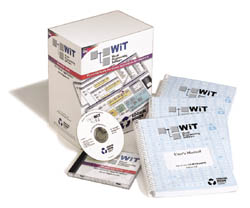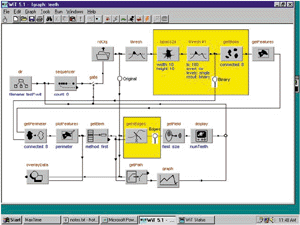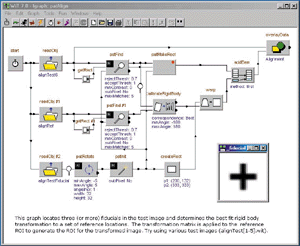|
||||||||||||||||||||||||||||||||||||||||||
|
||||||||||||||||||||||||||||||||||||||||||
WIT for Graphical Programming
Back to Software
Back to Manufactures

| Overview |
WiT is the first visual programming package to combine multiple Pentium execution with MMX-based image processing operators. A fully featured graphical programming environment for image processing development, WiT uses block diagrams to express algorithms. Now OEMs can integrate WiT as a value added library using the FastSeries, a collection of "C" callable vision libraries for object character recognition, machine inspection, alignment, barcode reading and web inspection.
- Over 200 proven image processing and analysis operations
- Supports popular frame grabbers for analog, color and digital acquisition
- Accelerates execution using multiple threads, DSPs and pipeline hardware
- Integrates effectively with Visual Basic for custom interface design
- Supported by a run-time DLL complete with setup utilities
| Features |
- Intuitive block-diagram interface delivers rapid turnkey solutions
- Designed for Windows 95 and NT 4.0
- Quick prototyping
- Data visualization
- Interactive debugging
- Hardware acceleration
- Run-time development
| Applications |
- Machine inspection
- Biomedical analysis
- Security and surveillance
- Motion analysis
- Scientific research
- Educational programs
Igraphs
An imaging graph (igraph) is the cornerstone of a WiT application. An igraph presents an entire algorithm using proven building blocks to perform machine inspection, biomedical imaging scientific exploration and general image processing and analysis. igraphs are built by selecting appropriate icons to solve your task and connecting them up using links. Links direct data from one block to the next and can be configured to enable probes or break points. Parameters for operators are easily changed with quick pop-up dialog panels. All the standard features of a CAD-like environment support fast design of an igraph. Flow control is handled by special operators to perform looping, if-then-else, sequencing of large data sets, collecting, I/O, counting, and general manipulation.


Encapsulate an igraph as an operator
- Hide unnecessary detail
- Promote reuse of common processing techniques
- Unlimited nesting
- Track down connections with trace tool
Use graphical annotations to enhance readability
- Add text and graphical objects
- Change colors and fonts
- Control stacking order
- Measure execution speed with stopwatches
- Over 200 processing functions
WiT can be used in industrial, scientific and biomedical applications and perform the following functions:
- Separate touching blobs with the distance map and watershed operators
- Determine rotation angle with Hough transform and pick out all "W" letters with template matching
- Remove noise with median filtering and smoothing
- Locate capacitors with RGB thresholding and blob analysis
Fast execution
Automatic parallel processing on multi-processor computers running Windows NT.
Frame grabbers
- PCI-bus
- Transparent use of pipeline hardware and DSPs
Ethernet
Utilize network resources: computers, frame grabbers
Comprehensive visualization tools
- Gray scale and color images
- X and Y profile plots
- Magnifier to inspect exact pixel values
- Pseudocoloring with custom color maps
- Group control of images. e.g. tie mouse movements across multiple image to compare X profiles
Surfaces
- 3D perspective view of images
- Gray-level intensities plotted as height
- Interactive viewing controls
|
If you like this page, please recommend it and share it. |
|||
| More | |||



